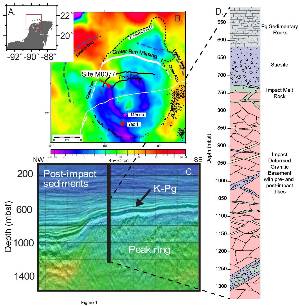Spring 2021
| Speaker: | Michael Whalen, UAF Department of Geosciences and Geophysical Institute |
| Title: |
"The First Year of the Cenozoic, the Record from Ground Zero" |
| Date: | February 25, 2022 |
| Time: | 11:45am |
| Location: | Contact instructor for details. jemezger@alaska.edu |

Abstract:
The Chicxulub impact led to the formation of a ~200-km wide by ~1-km deep crater on México’s Yucatán Peninsula. Over a period of hours after the impact the ocean re-entered and covered the impact basin beneath several hundred meters of water. A suite of impactites were deposited across the crater during crater formation, and by the resurge, tsunami and seiche events that followed. International Ocean Discovery Program/International Continental Scientific Drilling Program Expedition 364 drilled into the peak ring of the Chicxulub crater and recovered ~130 m of impact deposits (melt rock and breccia) and a 75-cm thick, fine-grained, carbonate-rich “Transitional Unit”, above which normal marine sedimentation resumed.
This talk will explore the major depositional processes associated with the emplacement of the 130 m thick impactites and the overlying Transitional Unit. The record suggests that, within minutes of the impact, centrally uplifted temporarily fluidized basement rock collapsed outwards to form a peak ring and was covered by > 40 m of impact melt rock and coarse-grained suevite emplaced in a ground-hugging flow. Within tens of minutes, ocean resurge deposited a 10 m-thick layer of suevite with increased particle roundness and sorting. Within hours, settling, seiches and gravity flows deposited a fining-upwards sequence of suevite in the now flooded crater followed by tsunami that deposited unidirectional cross-bedded, sand-sized layers. This interval is enriched in polycyclic aromatic hydrocarbons and overlain by abundant charcoal fragments providing direct evidence for impact-induced wildfires
The dominant depositional motif in the upper suevite and the Transitional Unit is of rapid sedimentation characterized by graded bedding, local cross bedding, and evidence of oscillatory currents. The lower Transitional Unit records the change from deposition of dominantly sand-sized to mainly silt to clay sized material with impact debris that decreases in both grain size and abundance upward. The middle part of the Transitional Unit is interrupted by a 20 cm thick, soft sediment slump overlain by graded and oscillatory current cross-laminated beds. The uppermost Transitional Unit is also soft sediment deformed, contains trace fossils, and an increasing abundance of planktic foraminifer and calcareous nannoplankton survivors. The Transitional Unit, as with similar deposits in other marine target impact craters, records the final phases of impact-related sedimentation prior to resumption of normal marine conditions.
Timing of deposition of the Transitional Unit is complicated to ascertain. The repetitive normally graded laminae, both below and above the soft sediment deformed interval, record rapid deposition from currents driven by tsunami and seiches, processes that likely operated for weeks to potentially years post-impact due to subsequent continental margin collapse events. Highly siderophile element-enrichment at the top of the unit is likely from fine-grained ejecta that circulated in the atmosphere for one to several years prior to settling. The Transitional Unit is thus an exquisite record of the final phases of impact-induced sedimentation related to one of the most consequential events in Earth history.


